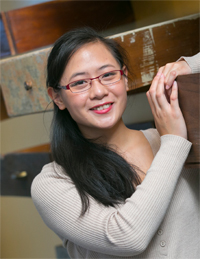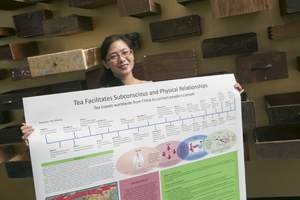Researcher of the Month
January 2016
Amy Dang Asian & Asian American Studies major (December 2015 graduate)
Asian & Asian American Studies major (December 2015 graduate)
Research Mentors: Dr. Peg Christoff, Asian & Asian American Studies; Dr. Gregory Ruf and Dr. Timothy August, Cultural Analysis & Theory
For Amy Dang, an Asian & Asian American Studies major now graduating summa cum laude (Dec. '15), doing a senior research class project in her last semester at SB was a challenging, fulfilling, and personal experience. Amy’s capstone project for AAS401: Senior Seminar in Asian & Asian American Studies focuses on the Chinese tea culture, beginning with an exploration of the Bai tea ceremony and tea cultures and values in other Chinese ethnic minority groups; and expanding to an investigation of how tea facilitates relationships worldwide (spiritual, social, political, and economic). The final product was a poster, and a class presentation. For her AAS project, Amy worked with Dr. Peg Christoff, the course instructor; and consulted with Dr. Gregory Ruf and Dr. Timothy August of the Cultural Analysis and Theory Department. Amy reflects that though she was an American-born Chinese, she had never realized the full significance of tea to her or to her family until she worked on this project: “I loved this project. I was more engaged in it because I had some personal background and experience in it. So I feel more connected to my culture …”
The project also drew upon some previous experiences, including a visit Amy made to China in summer 2012 where she was introduced to the Gong Fu tea ceremony practice by her uncle. Amy also became steeped in tea culture by working at Teavana during 2013-2014. At SB, Amy has enjoyed being able to enhance her understanding of Chinese history and culture in her major and has earned top honors: she was inducted to Phi Beta Kappa, and is the recipient of the Shi Ming Hu Memorial Endowment for Leadership & Eli Seifman Chinese Studies Awards. Amy enjoys creating art (especially watercolor and ink on canvas, as well as digital art) and has taken studio classes every semester. A resident of Nyack, NY, Amy transferred from Rockland Community College in 2014, and is the first in her family to earn a college degree. Below are excerpts from her interview with Karen Kernan, URECA Director.
The Interview:
Karen. Tell me about your current research.
Amy. I researched Chinese tea culture: how tea travelled from China to other parts of
the world, how other countries responded to tea, and how tea is used to represent
an individual’s or country’s values and beliefs in their tea ceremonies. When people
drink tea they share a sense of commensality and they form a kind of bond when they
talk over tea and they have this experience that they share together. And then there’s
that spirituality aspect of it that originated from China that comes partly from Buddhism,
Daoism, and Confucianism. Tea plays an intricate role in cultural values as tea becomes
intertwined with poetry, art, identity, religion and spirituality. There’s also the
political aspect where tea trade and politics are involved. Sometimes tea can bond
certain countries...So for my project, I looked at how tea is reflected in people
using it and how it facilitates a relationship outward and inward from individual
to people to people.
What got you started on this research topic?
For the Asian seminar class we were given free choice of a topic to do research on.
Originally I wanted to do an ethnographic study on different Chinese ethnic minorities
and how they performed tea ceremonies. I was intrigued by this Bai minority group
that practices a 3 course tea ceremony. They have a really interesting way of expressing
their values through the tea ceremony. There's three cups showing the three vicissitudes
of life: The first cup has a bitter taste to represent the obstacles and challenges
that everyone faces at one point or another in their life, the second cup has a sweet
taste to represent triumph of overcoming the obstacles, and the third cup has a strong
aftertaste to represent reflection on how far one has grown since they encountered
that obstacle. I first learned about the Bai tea ceremony from a Chinese course I
took at Rockland Community College.
Was it difficult to narrow down your topic?
If I started with the topic of tea in general, it would have been unmanageable. But
for me, I started out with a really narrow focus on the Bai tea culture and then I
slowly expanded my research outward. Initially I wanted to explore other tea ceremonies
that were similar to the Bai and how they had meaning and cultural values embedded
into it. But I couldn’t find enough material written in English to pursue this topic
in depth. To do a proper study, I would have to go to China and to study sources that
are not available to me in English (and I would need to become more fluent in Chinese).
So my project topic switched around a little, and I ended up primarily focusing on
how tea went around the world, and how tea facilitates relationships in several aspects:
spiritual, social , political and economics.
Tell me about your research process/methodology.
I looked online first to see what’s available, what kind of articles were there. I
also looked at a lot of newspaper articles, and books on Chinese culture and Chinese
tea. From there I went to talk to Professors Gregory Ruf and Tim August. Professor
Ruf gave me insight on the different ethnic minorities around the area that I want
to focus on initially, including the Bai. Professor Tim August focuses on food culture
and the meaning behind food and gave me some recommendations as well. And Professor
Christoff was very helpful. Whenever I came to her office, she would always have a
bunch of literature ready for me--many articles on tea. She was really helpful throughout
the whole process.
What was the output or end product for the class: a paper, or a class presentation?
Actually, we all worked on a website proposal, which we had to write up in three ways:
a graphic poster, an audio recording pitching our website idea; and a written proposal. The
poster that I made is essentially a website proposal showing a timeline of how tea
developed over time, and including interactive/storytelling components. I wanted to
include illustrations/comics of how tea formed relationships between people (…ever
since I was little I really wanted to make my own comic...), because that way people
will become more engaged at looking at the website.
 Had you done a poster before?
Had you done a poster before?
No, this was my first. As a humanities major, it's not something you’re typically
used to doing because mostly you are involved in doing papers or presentations. I
was surprised to realize all the aesthetics involved in making a poster. The poster
can’t be too wordy. You want to have a good amount of information but it has to be
eye catching. Initially when I did my first draft, it was too wordy and I had to cut
down on the text. It was a valuable process to go through. We all had to do several
different layouts for the class, and the whole class critiqued each other’s layouts
and gave feedback that was helpful. I like the end result, which was a compromise,
or combination of several of the earlier layouts.
Did you enjoy doing this senior project?
I did! I loved this project. I was more engaged in it because I had some personal
background and experience in it. So I feel more connected to my culture after looking
into so many readings…
The research itself was the most intricate project I’ve taken on so far throughout
my college career, in terms of the literature and the reading. And I enjoyed exploring
the idea of commensality and how people can form bonds through the smallest action.
I was interested in the articles I found about tea having a meditative purpose, and
can help people focus on the present moment, rather than being so caught up as we
are in the modern world, especially in the west, with the future. I had never realized
how important tea was in my family. We drink tea a lot. And tea is something that
we give and get from other family members. I just never fully realized its full importance
until I looked into it.
